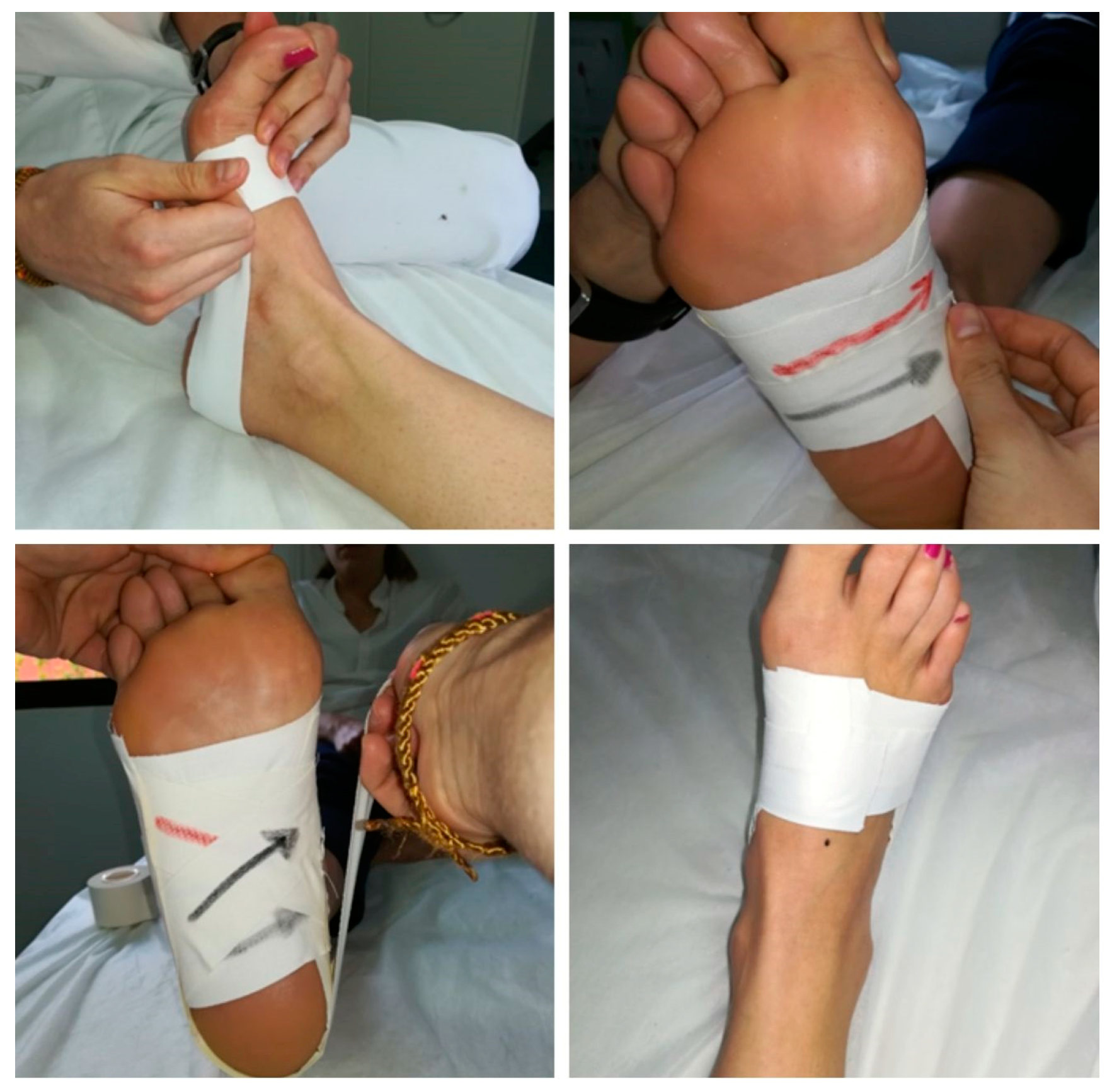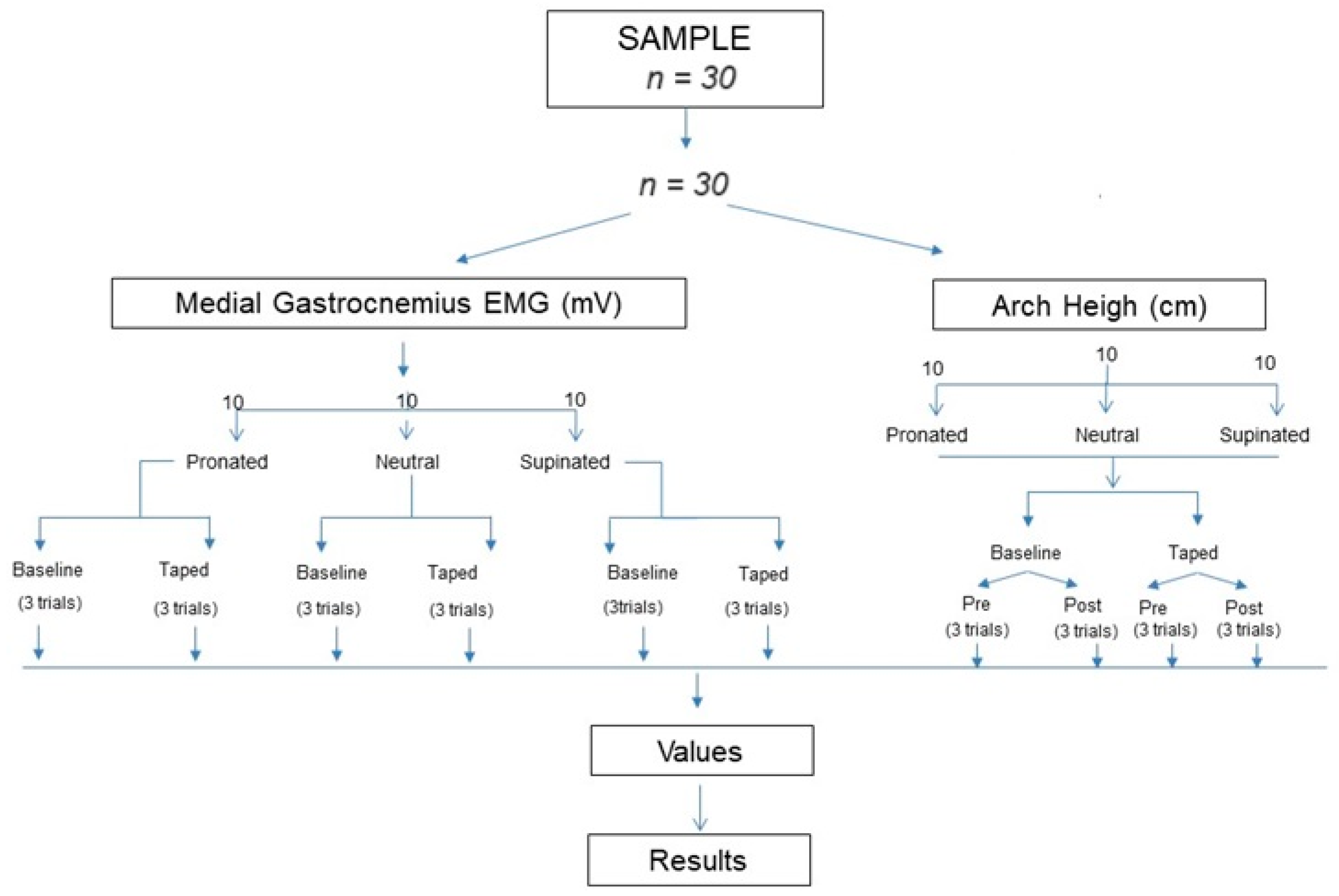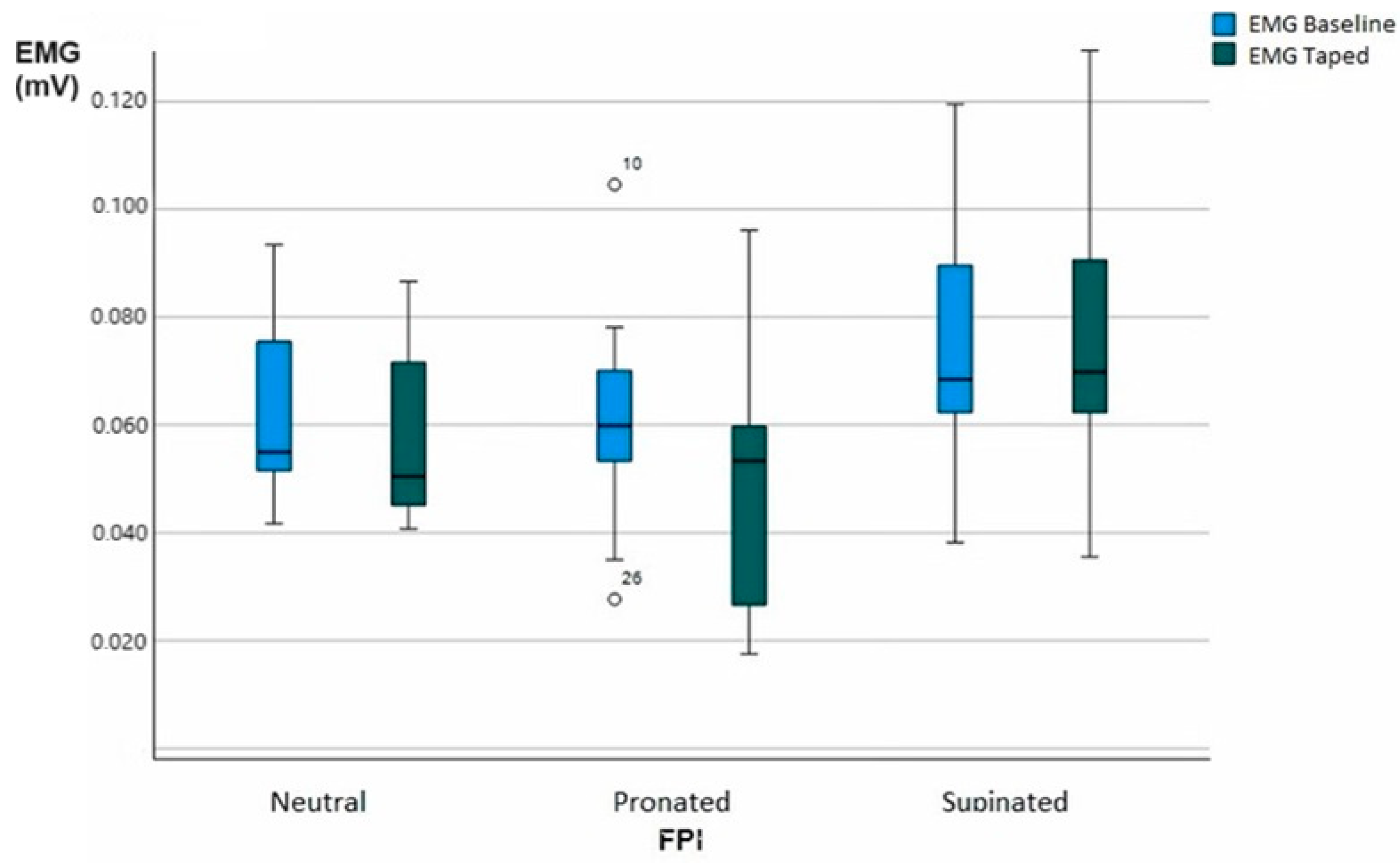Effects of Low-Dye Tape on Arch Height and Its Impact on the Medial Gastrocnemius Electromyographic Activity in Structurally Differentiable Foot Types: A Cross-Sectional Observational Study
Abstract
1. Introduction
2. Materials and Methods
2.1. Design and Sample Size
2.2. Participants
2.3. Instrumentation and Evaluations
2.4. Materials
2.5. Procedure
2.6. Statistical Analysis
3. Results
3.1. Arch Height
3.2. EMG
4. Discussion
4.1. Arch Height
4.2. Electromyography
4.3. Clinical Implication
4.4. Limitations
4.5. Future Lines of Investigation
5. Conclusions
Author Contributions
Funding
Institutional Review Board Statement
Informed Consent Statement
Data Availability Statement
Conflicts of Interest
References
- Kumar, K.; Chaudhar, N.; Kumar, R.; Raiya, S. Gray’s Anatomy: The Anatomical Basis of Clinical Practice, 40th ed.; Churchill Livingstone: Edinburgh, UK, 2008; ISBN 9780443066849. [Google Scholar]
- Kelikian, A.S.; Sarrafian, S.K.; Sarrafian, S.K. Sarrafian’s Anatomy of the Foot and Ankle: Descriptive, Topographical, Functional; Lippincott Williams & Wilkins: Philadelphia, PA, USA, 2011; p. 759. [Google Scholar]
- Pascual Huerta, J. The effect of the gastrocnemius on the plantar fascia. Foot Ankle Clin. 2014, 19, 701–718. [Google Scholar] [CrossRef] [PubMed]
- Wang, R.; Yan, S.; Schlippe, M.; Tarassova, O.; Pennati, G.V.; Lindberg, F.; Körting, C.; Destro, A.; Yang, L.; Shi, B.; et al. Passive Mechanical Properties of Human Medial Gastrocnemius and Soleus Musculotendinous Unit. Biomed Res. Int. 2021, 2021, 8899699. [Google Scholar] [CrossRef] [PubMed]
- Kirby, K.A. Rotational equilibrium across the subtalar joint axis. J. Am. Podiatr. Med. Assoc. 1989, 79, 1–14. [Google Scholar] [CrossRef] [PubMed]
- Murley, G.S.; Landorf, K.B.; Menz, H.B.; Bird, A.R. Effect of foot posture, foot orthoses and footwear on lower limb muscle activity during walking and running: A systematic review. Gait Posture 2009, 29, 172–187. [Google Scholar] [CrossRef]
- Milgrom, C.; Radeva-Petrova, D.R.; Finestone, A.; Nyska, M.; Mendelson, S.; Benjuya, N.; Simkin, A.; Burr, D. The effect of muscle fatigue on in vivo tibial strains. J. Biomech. 2007, 40, 845–850. [Google Scholar] [CrossRef]
- Telfer, S.; Abbott, M.; Steultjens, M.; Rafferty, D.; Woodburn, J. Dose–response effects of customised foot orthoses on lower limb muscle activity and plantar pressures in pronated foot type. Gait Posture 2013, 38, 443–449. [Google Scholar] [CrossRef]
- Dye, R.W. A strapping. 1939. J. Am. Podiatr. Med. Assoc. 2007, 97, 282–284. [Google Scholar] [CrossRef]
- Del Rossi, G.; Fiolkowski, P.; Horodyski, M.B.; Bishop, M.; Trimble, M. For how long do temporary techniques maintain the height of the medial longitudinal arch? Phys. Ther. Sport 2004, 2, 84–89. [Google Scholar] [CrossRef]
- Valmassy, R.L. Clinical Biomechanics of the Lower Extremities; Mosby: Maryland Heights, MO, USA, 1996; p. 510. [Google Scholar]
- Lange, B.; Chipchase, L.; Evans, A. The effect of low-Dye taping on plantar pressures, during gait, in subjects with navicular drop exceeding 10 mm. J. Orthop. Sports Phys. Ther. 2004, 34, 201–209. [Google Scholar] [CrossRef]
- Reinschmidt, C.; Van Den Bogert, A.J.; Murphy, N.; Lundberg, A.; Nigg, B.M. Tibiocalcaneal motion during running, measured with external and bone markers. Clin. Biomech. 1997, 12, 8–16. [Google Scholar] [CrossRef]
- Franettovich, M.; Chapman, A.; Vicenzino, B. Tape that increases medial longitudinal arch height also reduces leg muscle activity: A preliminary study. Med. Sci. Sports Exerc. 2008, 40, 593–600. [Google Scholar] [CrossRef] [PubMed]
- Franettovich, M.M.; Murley, G.S.; David, B.S.; Bird, A.R. A comparison of augmented low-Dye taping and ankle bracing on lower limb muscle activity during walking in adults with flat-arched foot posture. J. Sci. Med. Sport 2012, 15, 8–13. [Google Scholar] [CrossRef] [PubMed]
- Franettovich, M.; Chapman, A.R.; Blanch, P.; Vicenzino, B. Augmented low-Dye tape alters foot mobility and neuromotor control of gait in individuals with and without exercise related leg pain. J. Foot Ankle Res. 2010, 3, 5. [Google Scholar] [CrossRef] [PubMed]
- Franettovich, M.; Chapman, A.; Blanch, P.; Vicenzino, B. Continual use of augmented low-Dye taping increases arch height in standing but does not influence neuromotor control of gait. Gait Posture 2010, 31, 247–250. [Google Scholar] [CrossRef] [PubMed]
- Sánchez-Gómez, R.; Romero-Morales, C.; Gómez-Carrión, Á.; De-La-cruz-torres, B.; Zaragoza-García, I.; Anttila, P.; Kantola, M.; Ortuño-Soriano, I. Effects of Novel Inverted Rocker Orthoses for First Metatarsophalangeal Joint on Gastrocnemius Muscle Electromyographic Activity during Running: A Cross-Sectional Pilot Study. Sensors 2020, 20, 3205. [Google Scholar] [CrossRef] [PubMed]
- von Elm, E.; Altman, D.G.; Egger, M.; Pocock, S.J.; Gøtzsche, P.C.; Vandenbroucke, J.P. The strengthening the reporting of observational studies in epidemiology (STROBE) statement: Guidelines for reporting observational studies. Int. J. Surg. 2014, 12, 1495–1499. [Google Scholar] [CrossRef] [PubMed]
- Redmond, A.C.; Crosbie, J.; Ouvrier, R.A. Development and validation of a novel rating system for scoring standing foot posture: The Foot Posture Index. Clin. Biomech. 2006, 21, 89–98. [Google Scholar] [CrossRef] [PubMed]
- Gonzalez, M.C.; Correia, M.I.T.D.; Heymsfield, S.B. A requiem for BMI in the clinical setting. Curr. Opin. Clin. Nutr. Metab. Care 2017, 20, 314–321. [Google Scholar] [CrossRef]
- Naess, I.; Bø, K. Can maximal voluntary pelvic floor muscle contraction reduce vaginal resting pressure and resting EMG activity? Int. Urogynecol. J. 2018, 29, 1623–1627. [Google Scholar] [CrossRef]
- Roca-Dols, A.; Elena Losa-Iglesias, M.; Sánchez-Gómez, R.; Becerro-de-Bengoa-Vallejo, R.; López-López, D.; Palomo-López, P.; Rodríguez-Sanz, D.; Calvo-Lobo, C. Electromyography activity of triceps surae and tibialis anterior muscles related to various sports shoes. J. Mech. Behav. Biomed. Mater. 2018, 86, 158–171. [Google Scholar] [CrossRef]
- Landis, J.R.; Koch, G.G. Landis amd Koch1977_agreement of categorical data. Biometrics 1977, 33, 159–174. [Google Scholar] [CrossRef] [PubMed]
- Schulthies, S.S.; Draper, D.O. A Modified Low-Dye Taping Technique to Support the Medial Longitudinal Arch and Reduce Excessive Pronation. J. Athl. Train. 1995, 30, 266. [Google Scholar] [PubMed]
- Hermens, H.J.; Freriks, B.; Disselhorst-Klug, C.; Rau, G. Development of recommendations for SEMG sensors and sensor placement procedures. J. Electromyogr. Kinesiol. 2000, 10, 361–374. [Google Scholar] [CrossRef] [PubMed]
- Murley, G.S.; Buldt, A.K.; Trump, P.J.; Wickham, J.B. Tibialis posterior EMG activity during barefoot walking in people with neutral foot posture. J. Electromyogr. Kinesiol. 2009, 19, e69–e77. [Google Scholar] [CrossRef]
- Salsich, G.B.; Brechter, J.H.; Farwell, D.; Powers, C.M. The effects of patellar taping on knee kinetics, kinematics, and vastus lateralis muscle activity during stair ambulation in individuals with patellofemoral pain. J. Orthop. Sports Phys. Ther. 2002, 32, 3–10. [Google Scholar] [CrossRef]
- Cornwall, M.W.; McPoil, T.G. Relationship between static foot posture and foot mobility. J. Foot Ankle Res. 2011, 4, 4. [Google Scholar] [CrossRef]
- Tang, M.; Wang, L.; You, Y.; Li, J.; Hu, X. Effects of taping techniques on arch deformation in adults with pes planus: A meta-analysis. PLoS ONE 2021, 16, e0253567. [Google Scholar] [CrossRef]
- Newell, T.; Simon, J.; Docherty, C.L. Arch-Taping Techniques for Altering Navicular Height and Plantar Pressures During Activity. J. Athl. Train. 2015, 50, 825–832. [Google Scholar] [CrossRef]
- Holmes, C.F.; Wilcox, D.; Fletcher, J.P. Effect of a modified, low-dye medial longitudinal arch taping procedure on the subtalar joint neutral position before and after light exercise. J. Orthop. Sports Phys. Ther. 2002, 32, 194–201. [Google Scholar] [CrossRef][Green Version]
- Semciw, A.I.; Visvalingam, V.N.; Ganderton, C.; Lawrenson, P.; Hodges, P.W.; Kemp, J.; Collins, N.J. The immediate effect of foot orthoses on gluteal and lower limb muscle activity during overground walking in healthy young adults. Gait Posture 2021, 89, 102–108. [Google Scholar] [CrossRef]
- Hunt, A.E.; Smith, R.M. Mechanics and control of the flat versus normal foot during the stance phase of walking. Clin. Biomech. 2004, 19, 391–397. [Google Scholar] [CrossRef] [PubMed]
- Meier, K.; McPoil, T.G.; Cornwall, M.W.; Lyle, T. Use of antipronation taping to determine foot orthoses prescription: A case series. Res. Sports Med. 2008, 16, 257–271. [Google Scholar] [CrossRef] [PubMed]
- Zhou, J.P.; Yu, J.F.; Feng, Y.N.; Liu, C.L.; Su, P.; Shen, S.H.; Zhang, Z.J. Modulation in the elastic properties of gastrocnemius muscle heads in individuals with plantar fasciitis and its relationship with pain. Sci. Rep. 2020, 10, 2770. [Google Scholar] [CrossRef] [PubMed]





| Variable | n = 30 Mean ± SD (95% CI) |
|---|---|
| Age (years) | 33.85 ± 10.25 (24–55) |
| Weight (kg) | 73.08 ± 13.89 (54–103) |
| Height (m) | 1.74 ± 0.08 (1.58–1.92) |
| BMI (kg/m2) | 23.86 ± 3.10 (19.60–31.14) |
| Variable | Baseline Pre (cm) | Baseline Post (cm) | Taped Pre (cm) | Taped Post (cm) | ||||||||
|---|---|---|---|---|---|---|---|---|---|---|---|---|
| ICC (95%CI) | SEM | MDC | ICC (95%CI) | SEM | MDC | ICC (95%CI) | SEM | MDC | ICC (95%CI) | SEM | MDC | |
| AH | 0.997 (0.995–0.999) | 0.025 | 0.070 | 0.998 (0.996–0.999) | 0.022 | 0.060 | 0.997 (0.994–0.999) | 0.027 | 0.075 | 0.998 (0.996–0.999) | 0.020 | 0.054 |
| Variable | Baseline | Taped | ||||
|---|---|---|---|---|---|---|
| ICC (95%CI) | SEM | MDC | ICC (95%CI) | SEM | MDC | |
| EMG MG (mV) | 0.980 (0.962–0.990) | 0.003 | 0.008 | 0.994 (0.989–0.997) | 0.001 | 0.005 |
| Variable AH n = 30 | Baseline Pre Mean (cm) ± SD (95% CI) | Baseline Post Mean (mV) ± SD (95% CI) | Taped Pre Mean (mV) ± SD (95% CI) | Taped Post Mean (mV) ± SD (95% CI) | p-Value Baseline Pre vs. Baseline Post | p-Value Baseline Pre vs. Taped Pre | p-Value Baseline Pre vs. Taped Post | p-Value Taped Pre vs. Taped Post |
|---|---|---|---|---|---|---|---|---|
| Neutral | 5.61 ± 0.46 | 5.4 ± 0.43 | 5.92 ± 0.46 | 5.77 ± 0.39 | <0.001 ** | <0.05 * | <0.05 * | <0.05 * |
| (5.03–6.46) | (4.80–6.20) | (5.13–6.63) | (5.17–6.43) | |||||
| Pronated | 5.67 ± 0.57 | 5.43 ± 0.58 | 6.12 ± 0.53 | 6.01 ± 0.53 | <0.001 ** | <0.001 ** | <0.001 ** | <0.001 ** |
| (4.83–6.57) | (4.63–6.43) | (5.40–7.10) | (5.3–7.0) | |||||
| Supinated | 5.97 ± 0.36 | 5.87 ± 0.31 | 6.43 ± 0.32 | 6.28 ± 0.27 | <0.05 * | <0.05 * | <0.05 * | <0.001 ** |
| (5.53–6.57) | (5.50–6.40) | (5.90–6.97) | (5.83–6.70) |
| Variable EMG n = 30 | Baseline Mean (mV) ± SD (95% CI) | Taped Mean (mV) ± SD (95% CI) | p-Value EMG Baseline vs. EMG Taped |
|---|---|---|---|
| Neutral | 0.081 ± 0.016 | 0.076 ± 0.016 | <0.05 * |
| (0.061–0.113) | (0.060–0.106) | ||
| Pronated | 0.081 ± 0.022 | 0.068 ± 0.025 | <0.05 * |
| (0.047–0.124) | (0.037–0.116) | ||
| Supinated | 0.094 ± 0.025 | 0.096 ± 0.027 | 0.640 |
| (0.058–0.139) | (0.055–0.149) |
Disclaimer/Publisher’s Note: The statements, opinions and data contained in all publications are solely those of the individual author(s) and contributor(s) and not of MDPI and/or the editor(s). MDPI and/or the editor(s) disclaim responsibility for any injury to people or property resulting from any ideas, methods, instructions or products referred to in the content. |
© 2023 by the authors. Licensee MDPI, Basel, Switzerland. This article is an open access article distributed under the terms and conditions of the Creative Commons Attribution (CC BY) license (https://creativecommons.org/licenses/by/4.0/).
Share and Cite
Martínez-Sebastián, C.; Ramos-Petersen, L.; Gámez-Guijarro, M.; Alabau-Dasi, R.; Banwell, G.; Núñez-Fernández, A.; Sánchez-Gómez, R.; Gómez-Carrión, Á. Effects of Low-Dye Tape on Arch Height and Its Impact on the Medial Gastrocnemius Electromyographic Activity in Structurally Differentiable Foot Types: A Cross-Sectional Observational Study. Life 2023, 13, 2309. https://doi.org/10.3390/life13122309
Martínez-Sebastián C, Ramos-Petersen L, Gámez-Guijarro M, Alabau-Dasi R, Banwell G, Núñez-Fernández A, Sánchez-Gómez R, Gómez-Carrión Á. Effects of Low-Dye Tape on Arch Height and Its Impact on the Medial Gastrocnemius Electromyographic Activity in Structurally Differentiable Foot Types: A Cross-Sectional Observational Study. Life. 2023; 13(12):2309. https://doi.org/10.3390/life13122309
Chicago/Turabian StyleMartínez-Sebastián, Carlos, Laura Ramos-Petersen, María Gámez-Guijarro, Raquel Alabau-Dasi, George Banwell, Almudena Núñez-Fernández, Rubén Sánchez-Gómez, and Álvaro Gómez-Carrión. 2023. "Effects of Low-Dye Tape on Arch Height and Its Impact on the Medial Gastrocnemius Electromyographic Activity in Structurally Differentiable Foot Types: A Cross-Sectional Observational Study" Life 13, no. 12: 2309. https://doi.org/10.3390/life13122309
APA StyleMartínez-Sebastián, C., Ramos-Petersen, L., Gámez-Guijarro, M., Alabau-Dasi, R., Banwell, G., Núñez-Fernández, A., Sánchez-Gómez, R., & Gómez-Carrión, Á. (2023). Effects of Low-Dye Tape on Arch Height and Its Impact on the Medial Gastrocnemius Electromyographic Activity in Structurally Differentiable Foot Types: A Cross-Sectional Observational Study. Life, 13(12), 2309. https://doi.org/10.3390/life13122309











